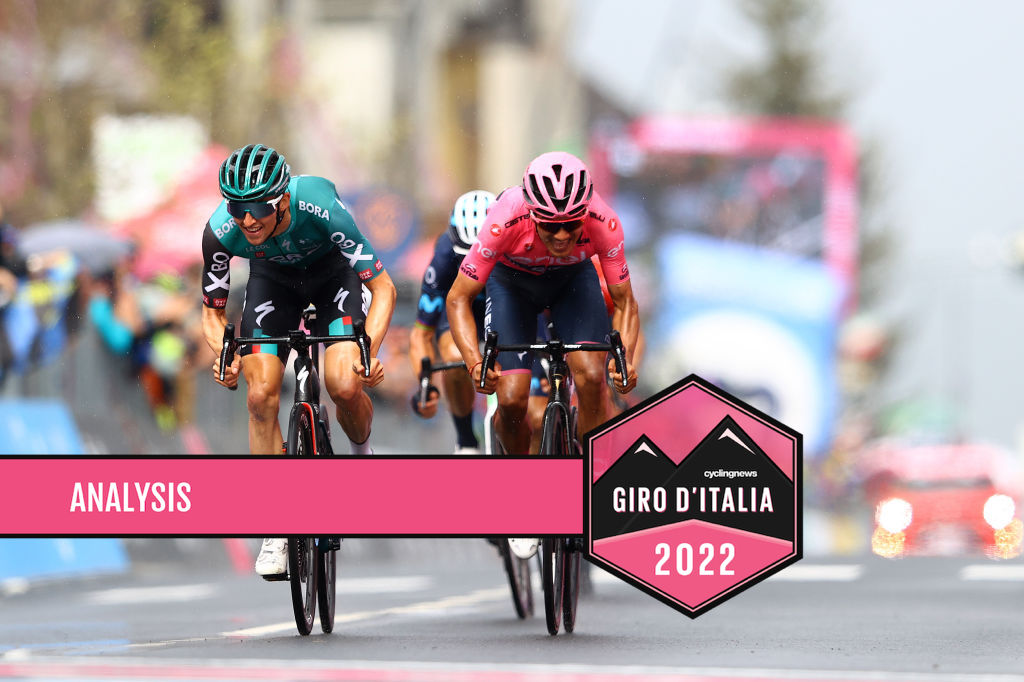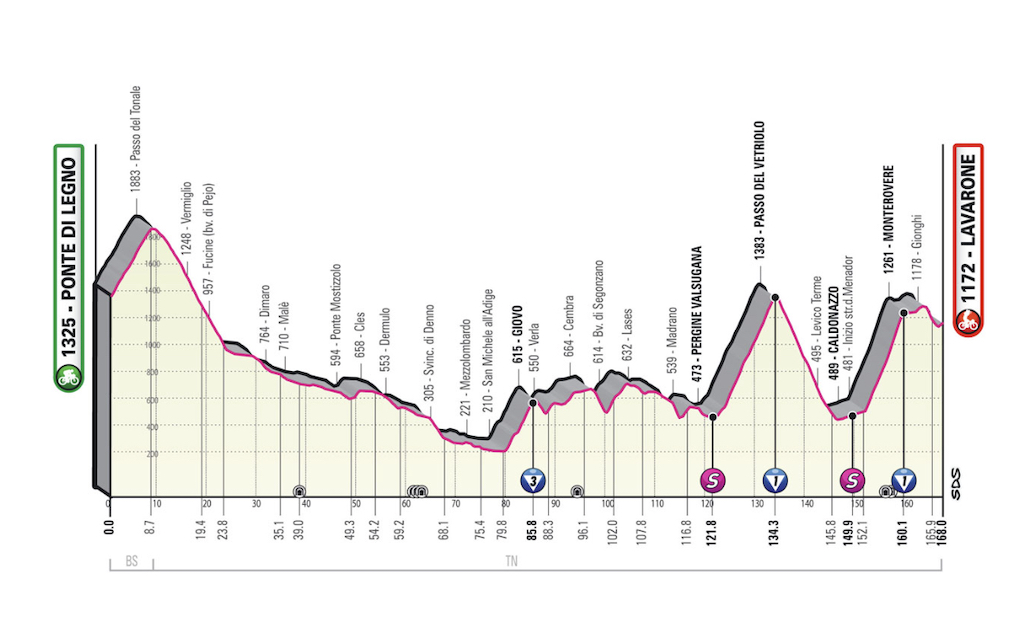Giro d'Italia remains race of 'small details' as it hits big mountains
Carapaz, Hindley, Landa and Almeida still locked inside a minute after Mortirolo stage

Three mountain passes, 202 kilometres and some 5,250 metres of total climbing couldn’t separate the strongest riders at this Giro d’Italia. Stage 16 brought the gruppo over Goletto di Cadino, the Mortirolo and the Santa Cristina, the kind of terrain where the difference might be measured in minutes.
Instead, the day ended with Richard Carapaz (Ineos Grenadiers), Jai Hindley (Bora-Hansgrohe) and Mikel Landa (Bahrain Victorious) scrapping over four bonus seconds in Aprica, while João Almeida (UAE Team Emirates) limited his losses to a minimum behind them. It’s been that kind of Giro.
“The small details will make the difference,” Carapaz said after he was pipped to third place on the stage – and those precious bonus seconds – by Hindley. In the overall standings, Carapaz’s lead has contracted to just three seconds over Hindley, who appears to have his measure in the sprint.
“Hindley was very strong today, and he’s faster than me in those situations,” Carapaz conceded. “He took back four seconds, but I think there are still important stages to come.”
Tuesday’s stage, however, was clearly among the most important – and demanding – of the entire Giro, yet the margins between the riders still in contention to wear pink in Verona remain wafer thin. In keeping with the tenor of this race to date, the most telling selection came from the back of the maglia rosa group rather than the front.
Domenico Pozzovivo (Intermarché-Wanty-Gobert Matériaux), a crash victim on the descent of the Mortirolo, eventually slid out of the reckoning on the Santa Cristina, dropping to sixth overall, 3:48 behind Carapaz. Vincenzo Nibali (Astana Qazaqstan), who had attacked on the way down the Mortirolo, rose three places overall to fifth, but he lost 40 more seconds on pink when he was distanced on the Santa Cristina, dropping to 3:40 behind Carapaz.
The four men ahead of Nibali in the overall standings, however, remain locked within a minute of each other. When Landa, teed up by his Bahrain Victorious squad, accelerated with purpose 4km from the top of the Santa Cristina, Carapaz and Hindley immediately came with him. Hindley, who looked the most comfortable on the climb, later followed through with a pair of bracing accelerations. Carapaz, still in pink but not quite convincing, parried the blows well without landing any of his own.
Get The Leadout Newsletter
The latest race content, interviews, features, reviews and expert buying guides, direct to your inbox!
“We tried with all the team to do a big rhythm, but Richard and Hindley are also very strong,” Landa said when he braked to a halt on the finish line in Aprica, flitting between Spanish, Italian and Basque as he talked to reporters through the stage.
After Nibali’s Astana guard had led up the Mortirolo to prepare his attack and Ineos had policed affairs in the valley towards Teglio to protect Carapaz, Bahrain Victorious took over on behalf of Landa ahead of the final climb. Despite an entanglement with Bilbao mid-way up, Landa hit his lines on cue, but Hindley and Carapaz knew what was coming and responded in kind. Much like at this point in 2020, it’s all far too close to call.
The Almeida factor
As on stage 9 to the Blockhaus, there was nothing to choose between the three strongmen on the day’s final ascent. And, like that day in Abruzzo, they failed to distance adequately their most persistent chaser.
In the three Giro appearances of his short career to date, Almeida has put together the most dogged sequence of pursuits committed to film since Marshal Sam Gerard hunted Dr. Richard Kimble. The Portuguese rider’s stalking of the leaders over the Valico di Santa Cristina here was just the latest addition to a collection that began with his remarkable solo effort on Piancavallo two years ago.
With his distinctive climbing position – head upright and shoulders slumped – Almeida often gives the impression that he is flagging, but he usually has the happy knack of limiting the damage regardless. An appropriate style, perhaps, for a stage dedicated to the Valtellina area’s sforzato (literally, ‘strained’) wine.
On Tuesday, Almeida was dropped with Nibali when Landa, Hindley and Carapaz punched clear with 10km remaining, but he kept that trio within his sights all the way up the Santa Cristina and down the treacherous descent into Aprica.
He reached the finish just 14 seconds behind them, and in the overall standings, he lies third at 44 seconds. With a 17.4km time trial to come in Verona on the final day, gaining more ground on Almeida is of increasing urgency for Carapaz, Hindley and Landa.
“I think we took important seconds, and that’s good for us,” Carapaz insisted beside the podium when asked about Almeida’s continuing proximity. “I think it was a positive day. Before thinking about Verona, we have to think about the stages coming up. There are a lot of hard kilometres still to come.”
The road ahead

Carapaz and company will cover a hefty chunk of those hard kilometres on Wednesday, when the Giro crosses into the Trentino for another day of climbing. For the first – and perhaps only, depending on one’s definition of Friday’s sortie into Slovenia – time in this Giro, the gruppo faces back-to-back mountain stages. “There are a lot of mountains to come and there’s a lot of fatigue,” Carapaz warned. “That will weigh heavily.”
Stage 17 from Ponte di Legno to Lavarone crams another 4,000 metres or so of climbing into its 168 kilometres, starting with the ascent of the steady Passo del Tonale at the very beginning of the stage. A long, long descent into Moser – and Gilberto Simoni – country in Palù di Giovo offsets that early hardship, though the road grows increasingly undulating as the race traverses the Valle di Mocheni.
The day’s principal difficulties are shoehorned into the final 50km, with the category 1 Passo del Vertriolo (11.8km at 7.7%) followed by the even tougher ascent of the Salita del Menador (7.9km at 9.9%).
The Menador, officially labelled as Monterovere in the road book, is making its debut in the Giro after the sinuous road up the climb was widened last year, but the tightly packed clutch of hairpins and tunnels has been here for over a century. They were originally carved into the rock face as a supply line by the Austro-Hungarian Kaiserjäger regiment during World War I.
Cruelly, the steepest sections of the Menador come near the summit, with the gradient stiffening to 15% with a little over a kilometre from the top. That summit, meanwhile, is followed by a rippling 8km plateau to the finish at Lavarone, but even Almeida himself might struggle to chase back on here if he is distanced on the Kaiserjägerstraße.
The tactical approach of the respective contenders adds another layer of intrigue. On Tuesday, both Landa and Hindley placed teammates in the early break with a view to enjoying their support later on. Astana rode to tee up Nibali ahead of the descent of the Mortirolo, while Ineos had numbers ahead of the Santa Cristina but didn’t make them count on the climb itself. Who, precisely, will take up the reins on Wednesday, and where? Or will accumulated fatigue begin to separate the four strongmen?
“Tomorrow is a tough stage too and we’ll feel the efforts we made today,” Landa said as he soft-pedalled away from the finish area in Aprica, and logic certainly suggests that at least one of the four riders locked within a minute of each other will concede significant ground at Lavarone.
And yet, the bonus seconds along the way will be keenly contested all the same. Or, as Carapaz put it: “I think all those small details are going to make a big difference.”

Barry Ryan was Head of Features at Cyclingnews. He has covered professional cycling since 2010, reporting from the Tour de France, Giro d’Italia and events from Argentina to Japan. His writing has appeared in The Independent, Procycling and Cycling Plus. He is the author of The Ascent: Sean Kelly, Stephen Roche and the Rise of Irish Cycling’s Golden Generation, published by Gill Books.